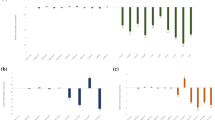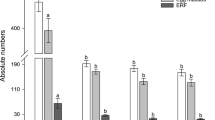Abstract
Root-knot nematodes (RKNs) are one of the most important biotic factors limiting crop productivity in many crop plants. The major RKN control strategies include development of resistant cultivars, application of nematicides and crop rotation, but each has its own limitations. In recent years, RNA interference (RNAi) has become a powerful approach for developing nematode resistance. The two housekeeping genes, splicing factor and integrase, of Meloidogyne incognita were targeted for engineering nematode resistance using a host-delivered RNAi (HD-RNAi) approach. Splicing factor and integrase genes are essential for nematode development as they are involved in RNA metabolism. Stable homozygous transgenic Arabidopsis lines expressing dsRNA for both genes were generated. In RNAi lines of splicing factor gene, the number of galls, females and egg masses was reduced by 71.4, 74.5 and 86.6%, respectively, as compared with the empty vector controls. Similarly, in RNAi lines of the integrase gene, the number of galls, females and egg masses was reduced up to 59.5, 66.8 and 63.4%, respectively, compared with the empty vector controls. Expression analysis revealed a reduction in mRNA abundance of both targeted genes in female nematodes feeding on transgenic plants expressing dsRNA constructs. The silencing of housekeeping genes in the nematodes through HD-RNAi significantly reduced root-knot nematode infectivity and suggests that they will be useful in developing RKN resistance in crop plants.




Similar content being viewed by others
References
Abad P, Gouzy J, Aury JM, Castagnone-Sereno P, Danchin EG, Deleury E, Perfus-Barbeoch L, Anthouard V, Artiguenave F, Blok VC, Caillaud MC, Coutinho PM, Dasilva C, De Luca F, Deau F, Esquibet M, Flutre T, Goldstone JV, Hamamouch N, Hewezi T, Jaillon O, Jubin C, Leonetti P, Magliano M, Maier TR, Markov GV, McVeigh P, Pesole G, Poulain J, Robinson-Rechavi M, Sallet E, Ségurens B, Steinbach D, Tytgat T, Ugarte E, van Ghelder C, Veronico P, Baum TJ, Blaxter M, Bleve-Zacheo T, Davis EL, Ewbank JJ, Favery B, Grenier E, Henrissat B, Jones JT, Laudet V, Maule AG, Quesneville H, Rosso MN, Schiex T, Smant G, Weissenbach J, Wincker P (2008) Genome sequence of the metazoan plant-parasitic nematode Meloidogyne incognita. Nat Biotechnol 26:909–915
Atamian HS, Roberts PA, Kaloshian I (2012) High and low throughput screens with root-knot nematodes Meloidogyne spp. J Vis Exp 61:e39
Bakhetia M, Urwin PE, Atkinson HJ (2008) Characterisation by RNAi of pioneer genes expressed in the dorsal pharyngeal gland cell of Heterodera glycines and the effects of combinatorial RNAi. Int J Parasitol 38:1589–1597
Carvalho LM, Benda ND, Vaughan MM, Cabrera AR, Hung K, Cox T, Abdo Z, Allen LH, Teal PE (2015) Mi-1-mediated nematode resistance in tomatoes is broken by short-term heat stress but recovers over time. J Nematol 47:133–140
Chitwood DJ (2003) Research on plant-parasitic nematode biology conducted by the United States Department of Agriculture-Agricultural Research Service. Pest Manag Sci 59:748–753
Clough SJ, Bent AF (1998) Floral dip: a simplified method for Agrobacterium-mediated transformation of Arabidopsis thaliana. Plant J 16:735–743
Danchin EG, Arguel MJ, Campan-Fournier A, Perfus-Barbeoch L, Magliano M, Rosso MN, Da Rocha M, Da Silva C, Nottet N, Labadie K, Guy J, Artiguenave F, Abad P (2013) Identification of novel target genes for safer and more specific control of root-knot nematodes from a pan-genome mining. PLoS Pathog 9:e1003745
Dinh PTY, Brown CR, Elling AA (2014a) RNA interference of effector gene Mc16D10L confers resistance against Meloidogyne chitwoodi in Arabidopsis and potato. Phytopathology 104:1098–1106
Dinh PTY, Zhang L, Brown CR, Elling AA (2014b) Plant-mediated RNA interference of effector gene Mc16D10L confers resistance against Meloidogyne chitwoodi in diverse genetic backgrounds of potato and reduces pathogenicity of nematode offspring. Nematology 16:669–682
Dong L, Xu J, Chen S, Li X, Zuo Y (2016) Mi-flp-18 and Mi-mpk-1 genes are potential targets for Meloidogyne incognita control. J Parasitol 102:208–213
Dutta TK, Papolu PK, Banakar P, Chaudhary D, Sirohi A, Rao U (2015) Tomato transgenic plants expressing hairpin construct of a nematode protease gene conferred enhanced resistance to root-knot nematodes. Front Microbiol 6:260
Eisenback JD, Sasser JN, and CC (1985) Diagnostic characters useful in the identification of the four most common species of root-knot nematodes (Meloidogyne spp.) In: Sasser JN, Carter CC (eds.) An advanced treatise on Meloidogyne 1: Biology and control, North Carolina State University Graphics, Raleigh, pp 95–112
Elling AA (2013) Major emerging problems with minor Meloidogyne species. Phytopathology 103:1092–1102
Fairbairn DJ, Cavallaro AS, Bernard M, Mahalinga-Iyer J, Graham MW, Botella JR (2007) Host-delivered RNAi: an effective strategy to silence genes in plant parasitic nematodes. Planta 226:1525–1533
Fire A, Xu S, Montgomery MK, Kostas SA, Driver SE, Mello CC (1998) Potent and specific genetic interference by double-stranded RNA in Caenorhabditis elegans. Nature 391:806–811
Huang G, Allen R, Davis EL, Baum TJ, Hussey RS (2006) Engineering broad root-knot resistance in transgenic plants by RNAi silencing of a conserved and essential root-knot nematode parasitism gene. Proc Natl Acad Sci USA 103:14302–14306
Ibrahim HMM, Alkharouf NW, Meyer SLF, Aly MA, Gamal El-Din Ael K, Hussein EH, Matthews BF (2011) Post-transcriptional gene silencing of root-knot nematode in transformed soybean roots. Exp Parasitol 127:90–99
Jaouannet M, Magliano M, Arguel MJ, Gourgues M, Evangelisti E, Abad P, Rosso MN (2013) The root-knot nematode calreticulin Mi-CRT is a key effector in plant defense suppression. Mol Plant Microbe Interact 26:97–105
Kamath RS, Fraser AG, Dong Y, Poulin G, Durbin R, Gotta M, Kanapin A, Le Bot N, Moreno S, Sohrmann M, Welchman DP, Zipperlen P, Ahringer J (2003) Systematic functional analysis of the Caenorhabditis elegans genome using RNAi. Nature 421:231–237
Klink VP, Kim KH, Martins V, Macdonald MH, Beard HS, Alkharouf NW, Lee SK, Park SC, Matthews BF (2009) A correlation between host-mediated expression of parasite genes as tandem inverted repeats and abrogation of development of female Heterodera glycines cyst formation during infection of Glycine max. Planta 230:53–71
Li J, Todd TC, Oakley TR, Lee J, Trick HN (2010) Host-derived suppression of nematode reproductive and fitness genes decreases fecundity of Heterodera glycines Ichinohe. Planta 232:775–785
Lourenço-Tessutti IT, Souza Junior JDA, Martins-de-Sa D, Viana AA, Carneiro RM, Togawa RC, de Almeida-Engler J, Batista JA, Silva MC, Fragoso RR, Grossi-de-Sa MF (2015) Knock-down of heat-shock protein 90 and isocitrate lyase gene expression reduced root-knot nematode reproduction. Phytopathology 105:628–637
Niu J, Jian H, Xu J, Chen C, Guo Q, Liu Q, Guo Y (2012) RNAi silencing of the Meloidogyne incognita Rpn7 gene reduces nematode parasitic success. Eur J Plant Pathol 134:131–144
Niu J, Liu P, Liu Q, Chen C, Guo Q, Yin J, Yang G, Jian H (2016) Msp40 effector of root-knot nematode manipulates plant immunity to facilitate parasitism. Sci Rep 6:19443
Papolu PK, Gantasala NP, Kamaraju D, Banakar P, Sreevathsa R, Rao U (2013) Utility of host delivered RNAi of two FMRF amide like peptides, flp-14 and flp-18, for the management of root knot nematode, Meloidogyne incognita. PLoS One 8:e80603
Rosso MN, Jones JT, Abad P (2009) RNAi and functional genomics in plant parasitic nematodes. Annu Rev Phytopathol 47:207–232
Rozen S, Skaletsky H (2000) Primer3 on the WWW for general users and for biologist programmers. Methods Mol Biol 132:365–386
Sindhu AS, Maier TR, Mitchum MG, Hussey RS, Davis EL, Baum TJ (2009) Effective and specific in planta RNAi in cyst nematodes: expression interference of four parasitism genes reduces parasitic success. J Exp Bot 60:315–324
Steeves RM, Todd TC, Essig JS, Trick HN (2006) Transgenic soybeans expressing siRNAs specific to a major sperm protein gene suppress Heterodera glycines reproduction. Funct Plant Biol 33:991–999
Tamilarasan S, Rajam MV (2013) Engineering crop plants for nematode resistance through host-herived RNA interference. Cell Dev Biol 2:114
Vos P, Simons G, Jesse T, Wijbrandi J, Heinen L, Hogers R, Frijters A, Groenendijk J, Diergaarde P, Reijans M, Fierens-Onstenk J, de Both M, Peleman J, Liharska T, Hontelez J, Zabeau M (1998) The tomato Mi-1 gene confers resistance to both root-knot nematodes and potato aphids. Nat Biotechnol 16:1365–1369
Williamson VM (1998) Root-knot nematode resistance genes in tomato and their potential for future use. Annu Rev Phytopathol 36:277–293
Xue B, Hamamouch N, Li C, Huang G, Hussey RS, Baum TJ, Davis EL (2013) The 8D05 parasitism gene of Meloidogyne incognita is required for successful infection of host roots. Phytopathology 103:175–181
Yadav BC, Veluthambi K, Subramaniam K (2006) Host-generated double stranded RNA induces RNAi in plant-parasitic nematodes and protects the host from infection. Mol Biochem Parasitol 148:219–222
Zijlstra C, Donkers-Venne DTHM, Fargette M (2000) Identification of Meloidogyne incognita, M. javanica and M. arenaria using sequence characterised amplified region (SCAR) based PCR assays. Nematology 2:847–853
Acknowledgements
We gratefully acknowledge the financial support from National Agricultural Innovative Project (NAIP) and NASF (National Agricultural Science Fund) previously called the National Fund for Basic Strategic and Frontier Application Research in Agriculture (NFBSFARA), Indian Council of Agricultural Research (ICAR), New Delhi, India. The authors thank Dr. K. V. Prabhu, Dr. Rajendra Singh and the staff of National Phytotron Facility (NPF), IARI, New Delhi, India for providing space in the greenhouse to maintain nematode culture on tomato plants and Arabidopsis thaliana in the growth chambers.
Author information
Authors and Affiliations
Corresponding author
Electronic supplementary material
Below is the link to the electronic supplementary material.

10327_2017_701_MOESM1_ESM.jpg
Supplementary Fig. 1 PCR-based confirmation of the presence of splicing factor and integrase genes in control and transgenic Arabidopsis plants expressing dsRNA of splicing factor and integrase genes. a) Amplification of splicing factor gene from DNA samples isolated from control and representative transgenic plants of three independent lines (SF-E1, SF-E2, SF-E3 and control samples were loaded in lanes 1, 2, 3 and 4, respectively). b) Amplification of integrase gene from DNA samples isolated from control and representative transgenic plants of three independent lines (integrase-E1, integrase-E2, integrase-E3 and control samples were loaded in lanes 1, 2, 3 and 4 respectively). Lane M: 100 bp ladder marker. (JPG 109 KB)

10327_2017_701_MOESM2_ESM.jpg
Supplementary Fig. 2 RT-PCR based expression analysis of splicing factor and integrase genes in control and transgenic Arabidopsis plants expressing dsRNA of splicing factor and integrase genes. a) Expression of splicing factor gene from the RNA samples isolated from control and representative transgenic plants of three independent lines (SF-E1, SF-E2, SF-E3 and control samples were loaded in lanes 1, 2, 3 and 4, respectively). b) Expression of integrase gene from RNA samples isolated from control and representative transgenic plants of three independent lines (integrase-E1, integrase-E2, integrase-E3 and control samples were loaded in lanes 1, 2, 3 and 4, respectively). Lane M: 100 bp ladder marker. (JPG 86 KB)
Rights and permissions
About this article
Cite this article
Kumar, A., Kakrana, A., Sirohi, A. et al. Host-delivered RNAi-mediated root-knot nematode resistance in Arabidopsis by targeting splicing factor and integrase genes. J Gen Plant Pathol 83, 91–97 (2017). https://doi.org/10.1007/s10327-017-0701-3
Received:
Accepted:
Published:
Issue Date:
DOI: https://doi.org/10.1007/s10327-017-0701-3




